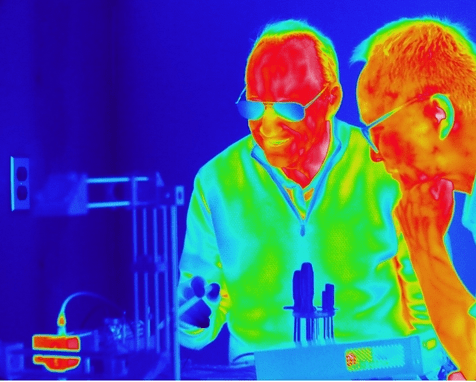Scientists thought they knew how heat was conducted through materials, but a new study now challenges the 200-year-old idea.
Fourier’s Law describes how heat is diffused from the hotter end to the colder end of an object at a rate that is proportional to the temperature difference and the area the heat is going through.
Although this process has been found not to work on a nanoscale, it also doesn’t seem to work on a bigger scale – also called the macroscale – either.
A team of researchers from the University of Massachusetts, Amherst looked at the law using transparent materials such as translucent polymers and inorganic glasses – like window glass.
The researchers thought that since the objects are see-through, light does not get totally absorbed by the materials and hypothesised that heat may travel through the materials in the form of thermal radiation as well.
Radiant heat is the heat we feel from the sun, as electromagnetic waves warm our skin when the sun shines.
Diffusion is how your tea mug will warm your hand after you’ve poured yourself a fresh cup.
And they were right.
‘This research began with a simple question,’ said senior author Dr Steve Granick.
‘What if heat could be transmitted [through solids] by another pathway, not just the one that people had assumed?’
To test this, the researchers clamped strips of test materials and hung them inside a custom vacuum chamber which removed the possibility of heat leaving the materials via the air.
Then they fired lasers at the materials to heat them up.
In one sample, they created a pulse of heat by using a laser to heat a small area, and, in the other sample, heated one side while keeping the other side cold.
Then, they looked through a special infrared camera to watch as the heat spread through their samples.
‘The data show heating [occurred] faster than can be attributed to diffusion,’ the researchers said.
‘Indicating that radiation contributes significantly to heat flux during early times after a heat pulse, though the relative contribution of radiation diminishes as diffusion becomes dominant at later times.’
Dr Granick said: ‘It’s not that Fourier’s Law is wrong, just that it doesn’t explain everything we see when it comes to heat transmission.’
Lead author Kaikai Zheng, a senior research fellow, said: ‘No one has tried this before. There’s something unexpected happening within translucent polymers.’
The team suggest that the materials radiate heat internally due to the structural imperfections which act as heat absorbers and sources. The team thinks this new finding could help engineers design new strategies for heat management with translucent materials.
The study has been published in PNAS.
Get in touch with our news team by emailing us at webnews@metro.co.uk.
For more stories like this, check our news page.
MORE : The Woolly mammoth could be brought back from extinction in just four years
MORE : Experts reveal the best foods to eat during Ramadan – and when to have them
MORE : Russia and China want to put a nuclear power plant on the moon
Get your need-to-know
latest news, feel-good stories, analysis and more
This site is protected by reCAPTCHA and the Google Privacy Policy and Terms of Service apply.












